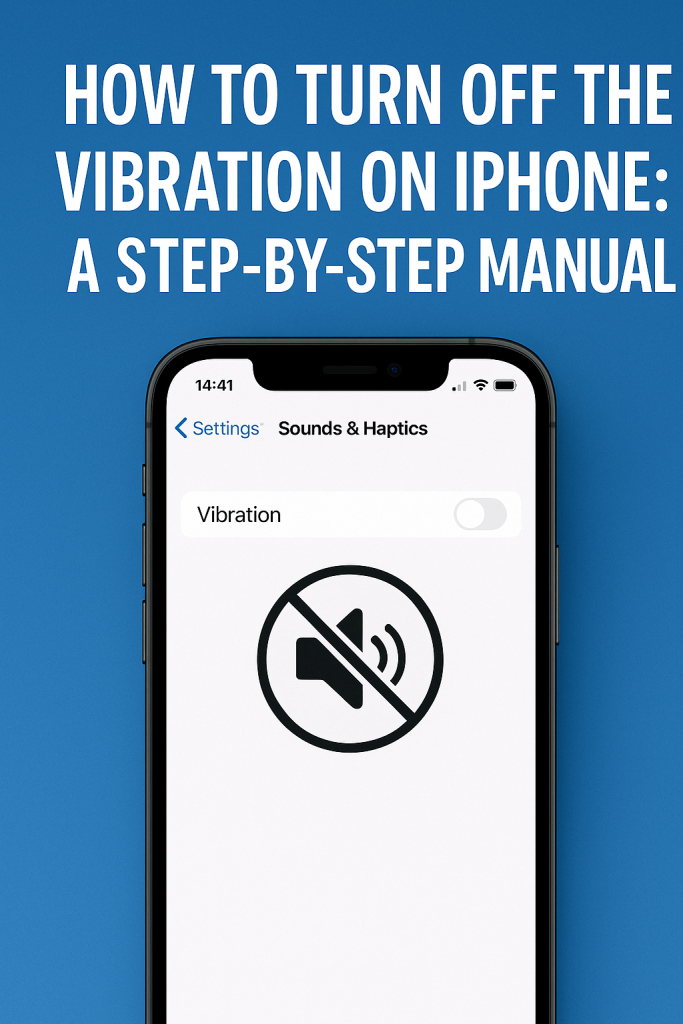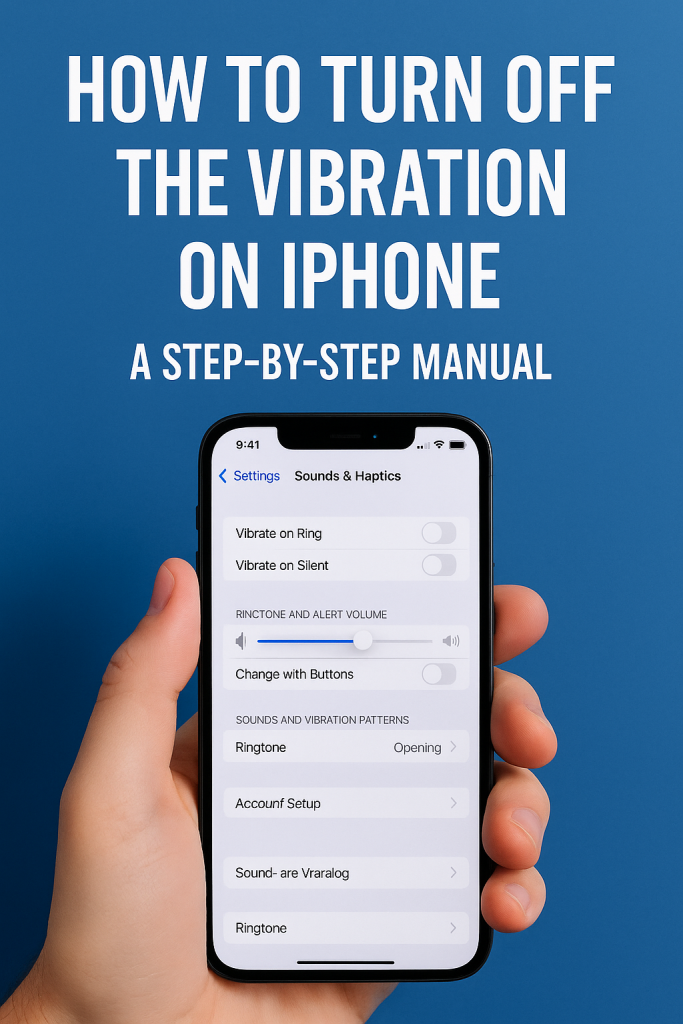It’s true that vibration alerts can be beneficial however they’re not suitable for all. I’ve experienced plenty of times when the constant ringing of my iPhone made me go nuts even when I thought I’d put everything on silent. It doesn’t matter if it’s for messages, calls or even in silent mode, at times we’d like the phones to cease. If you’re looking for a way to stop the vibration sound on your iPhone – whether an iPhone 11 13, 14, 15 or the newest iPhone 16 — this guide is ideal for you.
I’ll walk through every option menu, trick, and option to let you know the frequency (or when) you iPhone vibrates, as well as the way it behaves in Silent Mode and for specific notifications like calls or messages. Let’s take a look.

Why You Might Want to Turn Off Vibration on iPhone
Certain people like silence. Not solely for peace of head but also to conserve battery life, cut down on interruptions in sleep or to avoid triggering unnecessary noise during the classroom or meeting. Personally, I consider that vibration much more distracting than sound ringtone at times. Let’s not forget the times where your iPhone sits on a wooden table it’s vibrating like an electric chainsaw.
The ability to disable vibration gives you complete control over notifications from your phone and makes your experience more tranquil and personalised to your needs.
How to Turn Off All Vibration on iPhone (Global Setting)
There’s a master switch in the iPhone’s settings which completely blocks any vibration. Here’s how to locate it:
Step-by-step:
- Open the”Settings” app.
- Scroll down until you reach Accessibility.
- In the “Touch” section, choose the option”Vibration.
- Toggle Vibration to Off.

When this feature is turned off the iPhone will not vibrate in the event of an emergency, not even a call from the police. This is quite an extreme setting, however I prefer it for times to get complete quiet, like during meditation or when doing deep work.
Note: Emergency alerts will not be vibrating if this feature is disabled be aware of this.
How to Stop Vibration When iPhone is on Silent Mode
I was always wondering why my phone would keep vibrating even after I switched the switch to silence. Here’s how to stop it.
Quick solution:
- Go to Settings.
- Tap Sounds & Haptics.
- There are two options to choose from:
- Vibrate on Ring
- Vibrate on Silent
- Turn Vibrate on Silent to Off.
After that after that, turning on your iPhone to Silent will not trigger it to vibrate again. It will be completely silent, exactly as you’d think.
How to Turn Off Vibration for Incoming Calls on iPhone
Sometimes you’d like to hear the calls but not be able to feel them. Here’s how to disable the vibration of calls only
Customize Call Vibration:
- Go to Contacts, then choose the contact you wish to edit.
- Click Edit in the upper-right corner.
- Tap Ringtone.
- Tap the button Vibration, then select the option”None.
To alter the defaults on all phone calls.
- Go to Settings > Sounds & Haptics.
- Under Sounds and Vibration Patterns, tap Ringtone.
- Tap Vibration.
- Select None.
This stops you from having your iPhone from vibrating during calls, but it will still allow other notifications to be sent if required.
How to Turn Off Vibration for Messages Only
If you’re anything like me and receive many texts in a single day, shutting off the vibrating for messages is a great way to keep your sanity.
Here’s how to remove the vibrate feature for messages in text:
- Open Settings.
- Tap Sounds & Haptics.
- Tap Text Tone.
- Select Vibration.
- Tap None.
This will prevent your phone from ringing each time someone texts you, and let you be aware of notifications.
Turning Off Vibration for Notifications and App Alerts
Sometimes, it’s not calls and texts but applications such as Instagram or Slack always vibrating. Here’s how to stop it.
To disable vibrations for apps:
- Go to Settings > Notifications.
- Click on the app you want to use.
- Under Alerts make sure Sounds has been switched off.
- If the app permits the user to set custom settings, it might include a vibration toggle of its own.
Certain apps do not offer total control, but the majority of well-known apps offer this feature. For apps such as WhatsApp it is necessary to launch the app and then change the settings for vibration from within.
How to Turn Off Vibration on iPhone 13, 14, 15, and 16
The above steps work on all iPhone models, however newer models that run iOS 16-17 or iOS 18 often alter the interface a little. This is what you need to be aware of:
iPhone 13, 14, 15, and 16:
- Go to Settings > Sounds & Haptics.
- Turn off Vibrate on Silent and Vibrate on Ring.
- To get feedback from haptics For feedback haptic, go to System Haptics, and turn it off.
It will eliminate the tiny haptic tappings that you experience when you use things like the keyboard or switching switches. iPhones that are released after iPhone 13 make heavier use of haptics. Turning off this option will make the phone appear smaller and less “alive” in a subtle way.
How to Turn Off Vibrations on an iPhone using iOS 18
If you’ve recently updated up to iOS 18 (or above) You may notice minor changes to menu names, however the fundamental functions remain identical.
Global Vibration Control on iOS 18:
- Go to Settings > Accessibility > Touch > Vibration.
- Switch it off to disable all vibrations system-wide.
For call and message-specific vibrations The process under Sounds and Haptics is the same.
*Tip: When you update your iOS, iOS sometimes resets vibration patterns. Be sure to check these settings after every major update.
How to Customize or Remove Vibration Patterns Completely
Apple lets you design custom vibration patterns, or select none at all.
To accomplish this:
- Open Settings > Sounds & Haptics.
- Select the type of alert you want to use (e.g., Ringtone, Text Tone).
- Tap Vibration.
- There are custom options available such as Heartbeat, Quick** or”Symphony.
- Scroll down to the bottom, and then tap”None” to deactivate the alert’s vibration.
You can also tap Create a New Vibration if would prefer something less sombre instead of eliminating it completely.
How To Stop Your iPhone from vibrating to alerts from the System
Even with notifications turned off certain system alerts such as emergency Alerts or Earthquake Warnings could still be vibrating.
Here’s how to handle these:
- Go to Settings > Notifications.
- Scroll down to the bottom, and tap on Government AlertsScroll to the bottom and tap Government Alerts.
- You can turn off AMBER Alerts Emergency Alerts, AMBER Alerts as well as Public Safety Alerts.
They are made to alter settings to ensure safety Be cautious when turning them off.
FAQ Section
How can I tell if the vibration is totally off?
After switching off vibration under Accessibility > Touch* Test your phone by receiving a phone call or text message. If you don’t hear any buzz whatsoever, you’re good to go.
Will switching off vibration save the battery?
Yes, slightly. The haptic motor is powered by electricity which is why shutting it off could increase your battery life. This is especially true if you are getting numerous alerts.
Can I switch off the vibration at night?
There’s not a built-in schedule to vibration, however Focus Modes may help. Install a “Sleep Mode”** which blocks notifications and turns off vibrations for specific hours.
Is there an easy way or automated method to switch off vibration?
Yes! With the app Shortcuts you can build an automated system that shuts off vibrations in certain modes or areas. It’s a power-user choice that is worth the effort.
Final Thoughts
There’s no standard size that fits all in the world of notifications. Certain people are awed by vibrating alerts, while some (like me) are irritated and annoying. The good thing is that Apple offers us lots of control over the way our devices perform.
No matter if you’re using the iPhone 11 or the latest iPhone 16, these steps should allow you to have complete control over the vibrations. The key is knowing what to look for. Hope this article has helped make sense of what could be a confusing array of menus.
Have a look around and tweak setting until the iPhone seems to be at ease for you. It’s quiet when it isn’t active, alert when necessary, but never more than the minimum.